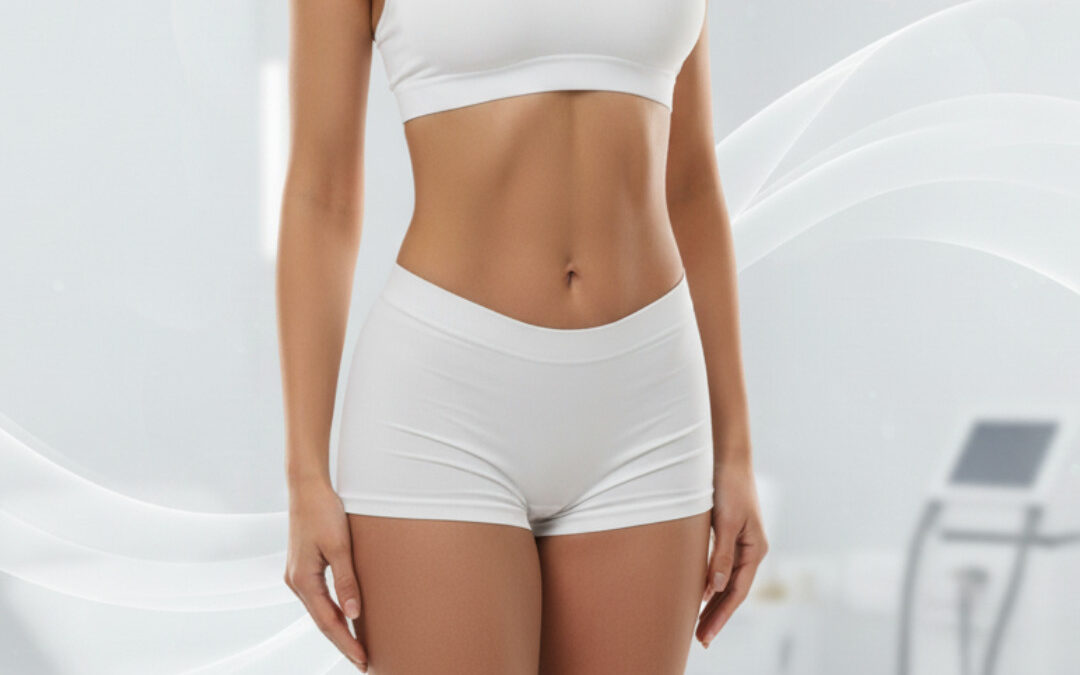Table of Contents
- What Is Body Sculpting?
- Does Body Sculpting Actually Work?
- How Effective Is Body Sculpting?
- What Can Body Sculpting Treat?
- Does Body Sculpting Work for Belly Fat?
- Does Body Sculpting Help with Cellulite?
- Does Body Sculpting Work on Loose Skin?
- The Technologies Behind Professional Body Sculpting
- Do At-Home Body Sculpting Machines Work?
- Is Body Sculpting Safe?
- Does Body Sculpting Hurt?
- How Long Do Body Sculpting Results Last?
- Can You Do Body Sculpting While Pregnant or Breastfeeding?
- How Much Does Body Sculpting Cost?
- Is Body Sculpting Worth It?
- How to Get Started with Body Sculpting
- The Bottom Line
If you’ve been wondering whether body sculpting really works or if it’s worth the investment, you’re not alone. Thousands of people search for answers to these questions every month. In this comprehensive guide, we’ll answer all your burning questions about body sculpting and help you understand what to expect from modern, non-surgical body contouring treatments.
What Is Body Sculpting?
Body sculpting, also called body contouring, refers to treatments that reshape and tighten areas of your body by improving skin firmness and texture. Unlike surgical procedures, non-surgical body sculpting uses advanced technologies like gentle heat, sound waves, or light energy to stimulate your body’s natural collagen production, improve circulation, and smooth your skin’s surface.
The best part? No incisions, no anaesthetic, and zero downtime.
Does Body Sculpting Actually Work?
This is the million-dollar question, and the answer is: yes, when done with professional-grade technology and by experienced practitioners.
Non-invasive body contouring works by warming or stimulating targeted layers of your skin to trigger collagen and elastin production. Over the following weeks and months, your skin naturally becomes tighter, smoother, and more resilient. The key word here is “naturally” – results develop gradually as your body responds to the treatment.
However, it’s important to understand that body sculpting isn’t a weight-loss procedure. Instead, it enhances tone and definition, complementing healthy lifestyle habits like proper nutrition and regular exercise.
How Effective Is Body Sculpting?
The effectiveness of body sculpting depends on several factors:
- Your starting point: People with mild to moderate skin laxity typically see the best results.
- The technology used: Professional-grade equipment like HIFU, RF microneedling, and enzyme therapy deliver measurably better results than at-home devices.
- Number of sessions: Most people need multiple sessions for optimal results. While some improvement may be visible after one treatment, a series of 3–6 sessions typically provides the most dramatic and lasting transformation.
- Your body’s response: Since these treatments work with your body’s natural healing and collagen production, individual results vary based on age, skin type, and overall health.
What Can Body Sculpting Treat?
Modern body contouring is incredibly versatile. Here are the most popular treatment areas:
- Abdomen and waist – tightening post-pregnancy skin or smoothing stubborn areas
- Upper arms – reducing the “bat wing” appearance
- Thighs – improving contour and reducing dimpling
- Buttocks – lifting and firming
- Knees – smoothing and tightening
- Back and bra line – reducing bulges and creating smoother lines
- Décolletage – rejuvenating chest skin
Does Body Sculpting Work for Belly Fat?
Body sculpting can help tighten and firm your abdominal area, but it’s not a fat-removal treatment in the traditional sense. If you have loose skin after weight loss or pregnancy (often called “mummy tummy”), treatments like RF microneedling can dramatically improve skin tightness and texture.
For best results with stubborn belly fat, body sculpting should be combined with a healthy diet and exercise routine. The treatments enhance your natural contours rather than replacing lifestyle changes.
Does Body Sculpting Help with Cellulite?
Yes, certain body contouring technologies can improve the appearance of cellulite. RF skin tightening, in particular, uses controlled radio-frequency heat to firm and smooth loose skin, often visibly reducing cellulite dimpling. The treatment works by strengthening the skin’s structure and improving circulation in affected areas.
Does Body Sculpting Work on Loose Skin?
This is where non-surgical body sculpting truly shines. Technologies like HIFU (High-Intensity Focused Ultrasound) and Sylfirm X RF Microneedling are specifically designed to tighten and lift sagging skin. HIFU reaches deeper layers of skin to gently lift areas like the abdomen, arms, or thighs, while RF microneedling remodels collagen where stretch marks or laxity appear.
If you’ve lost significant weight or had a baby, these treatments can help restore firmness without surgery.
The Technologies Behind Professional Body Sculpting
Not all body sculpting treatments are created equal. Here’s what sets professional treatments apart:
HIFU (High-Intensity Focused Ultrasound)
Tightens deeper layers of skin and gently lifts sagging areas. This technology can reach depths that topical treatments and at-home devices simply cannot.
RF Skin Tightening
Uses controlled radio-frequency heat to firm and smooth loose skin while improving the appearance of cellulite.
Sylfirm X RF Microneedling
Combines microneedling with radiofrequency energy to remodel collagen and refine texture, particularly effective for stretch marks and significant laxity.
DMK Enzyme Therapy
Stimulates your lymphatic system and increases blood circulation to improve skin function, tone, and texture from within.
Procell Microchanneling
Boosts skin regeneration using precision micro-channels and growth factors to improve overall tone.
Red Light Therapy
Promotes cellular renewal and enhances results between your main treatment sessions.
Do At-Home Body Sculpting Machines Work?
While at-home devices have improved over the years, they simply cannot match the power and precision of professional-grade technology. Clinical machines use higher energy levels, penetrate deeper into tissue, and are operated by trained practitioners who can customize settings for your specific needs and safety.
At-home devices might provide minimal improvement for very mild concerns, but if you’re serious about results, professional treatments are significantly more effective.
Is Body Sculpting Safe?
When performed with TGA-approved (or FDA-approved) technologies by qualified practitioners, non-surgical body contouring is very safe. These treatments are non-invasive, which means no cutting, no anaesthetic complications, and minimal risk compared to surgical alternatives.
Common side effects are mild and temporary, including slight redness, warmth, or tingling in the treated area that resolves within hours to a few days.
Does Body Sculpting Hurt?
Most people describe professional body sculpting treatments as comfortable with only mild sensations. You might feel warmth, tingling, or gentle pulsing during treatment, but it’s typically not painful. Technologies like RF and HIFU are designed with built-in cooling mechanisms to keep you comfortable throughout your session.
Treatment sessions typically last 30–90 minutes depending on the area being treated.
How Long Do Body Sculpting Results Last?
Results from body contouring treatments can last 1–3 years or longer, especially when you maintain a stable weight and healthy lifestyle. Since the treatments stimulate your body’s own collagen production, the improvements continue to develop for several months after your sessions end.
Many people choose to have maintenance treatments once or twice a year to sustain their results long-term.
Can You Do Body Sculpting While Pregnant or Breastfeeding?
It’s generally recommended to wait until after pregnancy and breastfeeding to undergo body sculpting treatments. Your body undergoes significant changes during this time, and it’s best to wait until your weight has stabilized and you’re no longer nursing before starting treatments.
How Much Does Body Sculpting Cost?
The cost of body sculpting varies based on the treatment area, technology used, and number of sessions needed. Professional treatments typically range from $250 to $650 per session, depending on the area and technology.
For example:
- DMK Enzyme Therapy for specific body areas: $250 per session
- RF Microneedling for various concerns: $297–$647 per area
- HIFU for upper arms: $550 per session
Most clinics offer package deals when you book multiple sessions, which can reduce the per-treatment cost. An initial consultation (often around $100) helps you understand exactly what you need and the total investment required.
Is Body Sculpting Worth It?
If you’re looking for visible improvement in skin tightness, texture, and contour without surgery, body sculpting can be absolutely worth it. The ideal candidates are those who:
- Have realistic expectations about gradual, natural-looking results
- Are at or near their goal weight
- Have mild to moderate skin laxity
- Want to complement their healthy lifestyle with body enhancement
- Prefer non-surgical options with no downtime
The investment makes the most sense when you choose experienced practitioners using professional-grade, clinically proven technologies.
How to Get Started with Body Sculpting
The first step is always a consultation with a qualified practitioner. They’ll assess your concerns, discuss your goals, examine your skin type and condition, and recommend a personalized treatment plan.
Look for clinics that offer:
- Multiple evidence-based technologies (not just one treatment option)
- Experienced, qualified staff with a strong track record
- TGA or FDA-approved equipment
- Transparent pricing with no hidden costs
- Realistic expectations and honest consultations
The Bottom Line
Body sculpting is a safe, effective way to tighten, smooth, and refine your body’s contours without surgery. While results take time to develop and aren’t a substitute for healthy habits, the right treatments with professional technology can deliver impressive, lasting improvements.
If you’ve been curious about whether body sculpting could work for you, a consultation with an experienced clinic can answer all your specific questions and help you create a personalized plan to achieve your goals.
Ready to explore your body contouring options? Look for clinics with extensive experience, comprehensive technology, and a commitment to realistic, natural results. Your journey to smoother, firmer skin starts with an informed decision and the right treatment partner.

